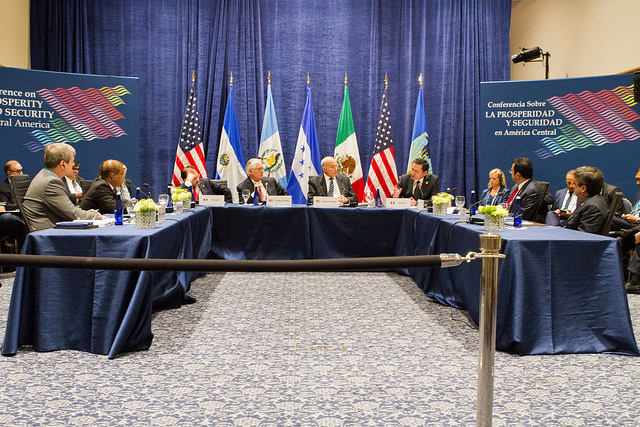Climate Change-Induced Migration from Central America
Last Thursday and Friday, the United States and Mexico co-hosted top officials from Guatemala, El Salvador, Honduras and other countries for the "Conference on Prosperity and Security in Central America." As the name suggests, the gathering aimed to spur a wide-ranging conversation for improving the region’s economic conditions, tackling gangs and organized crime, and slowing U.S.-bound migration.

Published by The Lawfare Institute
in Cooperation With

Last Thursday and Friday, the United States and Mexico co-hosted top officials from Guatemala, El Salvador, Honduras and other countries for the "Conference on Prosperity and Security in Central America." As the name suggests, the gathering aimed to spur a wide-ranging conversation for improving the region’s economic conditions, tackling gangs and organized crime, and slowing U.S.-bound migration. But one topic was conspicuously missing from the conference’s public record: climate change.
Most observers may not have found this omission noteworthy. Climate change-induced migration hasn’t been widely connected to the current waves of mass migration from Central American. And it’s no secret that the Trump administration has proven hostile to addressing climate change. But changing weather conditions are an undeniable factor in Central American migration and ignoring this issue will only undermine the conference’s ambitious agenda.
A few weeks ago, during a trip along the Mexico-Guatemala border I met a group of climate migrants. The three Hondurans—two brothers and their childhood friend—were all heading north after three years of unusual weather in their community of San José in the Copán district of western Honduras. They explained that the seasonal rains were coming too late and the hot, dry periods were lasting too long, leaving the soil more like dust than fertile land. Without decent crop yields, the families spent down their savings until they finally ran out of money, food, and the capacity to wait for better weather.
To learn more about their story, I called the local government office of Santa Rosa near the brothers’ hometown. Josselyn Hernandez, the administrator who took my call, confirmed that the weather was indeed shifting in the area. But the issue wasn’t just the rainy season’s unpredictability. Severe storms were rocking the region as we spoke, ruining crops and displacing entire families. "It rains every year," she explained during our call, "but never with this intensity."
These are not just a few fluke weather years. Studies consistently show that Honduras is one of the world’s most vulnerable countries when it comes to the effects of climate change. The western section of Honduras is particularly vulnerable to reduced precipitation and extreme or unpredictable weather events. Projections estimate a 10 to 20 percent decrease in rain over the next 30 years and a 2-degree Celsius increase in the average temperature.
Honduran migrants often report violence and poverty as the primary reasons for why they leave their country, and these two factors are both real and extremely well documented. Yet, these issues—especially in the coming years—may not be entirely separate from climate change. As farmers lose their livelihoods and ranchers are left unable to feed their cattle, more Central Americans will be left scrambling to make ends meet. This family-level instability then grows, resulting in clashes over scarce resources, more criminal activity, and increased tensions and potential for social conflict.
Central America’s governments ultimately hold the responsibility for implementing programs to help the region’s citizens to adapt and build resilience to climate change, and the United States and international community can and should continue to provide support. Yet in the absence of effective programs or policies, the migrants who are forced out of their homes because of droughts or extreme weather conditions don’t have many options. They can’t claim refugee status because changing weather patterns don’t meet the thresholds that international refugee frameworks demand. And other protections, such as the Temporary Protected Status that the United States granted to Hondurans after Hurricane Mitch in 1999, are unlikely to find favor under the current administration.
This inaction leaves climate-displaced individuals in a tough situation. The last time I heard from the group of Honduran migrants that I met along Mexico’s southern border, one was working without documents in Mexico City and two others were staying in a shelter along the U.S. border and wondering how to raise the money necessary to cross into the United States. If the U.S. and Mexican governments hope to keep these Hondurans, and others just like them, at home amid changing weather patterns, it will take not only a focus on creating jobs and improving security in the region, but also efforts to boost the region’s resilience to an increasingly unpredictable climate.





